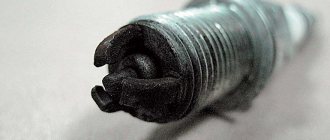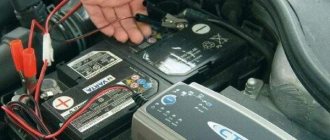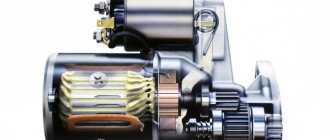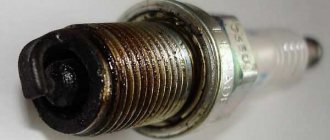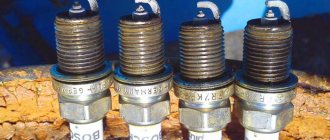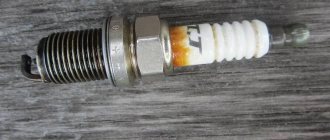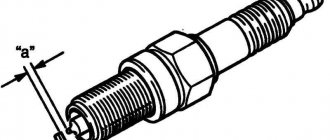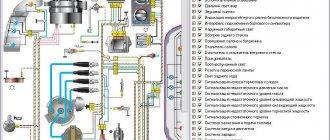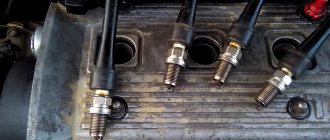Misfires on a VAZ 2114 indicate serious problems in the operation of the car’s engine. In order to find and eliminate the causes of the malfunction, it is necessary to diagnose the operation of the vehicle.
Causes of misfires
How to fix the problem?
What can multiple misfires lead to?
Video “Causes of misfires”
Comments and Reviews
Causes of misfires
If, on average, for every hundred operating cycles in the cylinder there are 3-4% cases of non-ignition of the mixture, then the VAZ 2114 engine management system begins to record misfires. There may be several reasons for this situation to occur and they do not depend on the type of engine - be it 1.5 liters or 1.6 liters.
The reasons why there are interruptions in the operation of the ignition system on the VAZ 2114 engine lie in various defects in the cylinder-piston group units, the gas distribution mechanism and the ignition system.
These problems can occur due to natural wear and tear of components or damage as a result of careless maintenance work:
- Incorrect functioning of the rough road sensor, which is installed on the VAZ 2114, meeting Euro 3 standards and higher. Because of this, when driving over uneven roads, there may be erroneous misfire signals, which disappear after driving on a good road.
- Poor mixture formation and the appearance of frost on the elements of the ignition system. Misfires may occur when starting the engine in low temperatures. On a working engine, such incidents disappear after a few seconds and are not a signal of a problem.
- Burnt out gasket between the head and block. In this case, misfires occur as the speed increases and the load on the power unit increases, i.e. during acceleration. At the same time, in idle mode the engine operates absolutely normally.
- Wear of cylinder rings and mirrors. Misfires appear on a cold engine and disappear as the unit warms up.
- Old or damaged spark plugs. Over time, the gap between the spark plug electrodes increases or becomes covered with a layer of soot. In this regard, there is not enough voltage in the ignition system for stable breakdown of the air gap and ignition.
- Faulty high-voltage wires or contacts on them. Over time, the insulation on the wires deteriorates or can become damaged during various engine maintenance tasks. With such defects, the cables are not able to provide a stable supply of high voltage to the spark plugs. The contacts on the wires themselves may become covered with corrosion products or become oily.
- Incorrect operation of the ignition module, which is installed on engines with an injector to supply a spark to the spark plugs.
- Using low-quality gasoline, which causes carbon deposits to form on the spark plugs and clog the nozzles on the injection nozzles.
- A decrease in compression pressure caused by worn rings on the pistons or loose valve seats. In turn, valve leaks can be caused by the formation of carbon deposits on the mating surfaces and incorrect adjustment of the drive mechanism.
- The engine sucks in excess air through leaks in the working mixture supply system.
The video from the KV Avtoservis channel presents the diagnosis and elimination of the cause of the misfire error.
Diagnostics
The first signal of problems with the engine is the lighting of the Check Engine indicator on the instrument panel. If the car has a standard on-board computer, then you can read the ignition system errors on it. But it is not able to show the operation of the device in real time, so a more accurate way to determine the fault code is a diagnostic tool that is connected to a special connector.
Regardless of the type of equipment to check, there are several main error codes that occur when a VAZ 2114 misfires:
- P0300 - a general problem in the system, the presence of numerous misfires on all cylinders;
- P0301 - malfunction of the spark plug of the first cylinder (cylinders are counted from the unit drive pulley);
- P0302 - problems with the functioning of the second cylinder;
- P0303 - problem in the third cylinder;
- P0304 - malfunction of the fourth cylinder.
The additional brake light does not light up
If the additional brake light does not light up, this indicates a break in its wires or an unreliable connection. It usually connects to one of the stock brake light sockets. It is necessary to ensure that the wires are securely fastened and that there are no signs of oxidation.
If they are present, it is necessary to cut off the damaged end of the wire, clean it again and connect it to the socket. If the cable is broken in another place, it is advisable to install a new one. In this case, it is better to use a thicker wire (to avoid recurrence of the malfunction).
How to fix the problem?
The way to eliminate problems that arise is to replace damaged or worn parts.
It is better to correct such defects in a specialized service, where they will first clarify the cause of the problem.
Some causes of misfires in the VAZ 2114 can be found and eliminated yourself:
- If gaps and error 300 appear on the computer screen, you need to unscrew all the spark plugs, check the gap between the electrodes and see if there is a lot of carbon deposits on their surface. For errors like 0301, 0302, etc., you need to pay special attention to the condition of the spark plug in this cylinder.
- It is necessary to visually inspect the wires leading to the spark plugs; if cracks are found on the surface, they should be replaced with new ones.
- Check the condition of the camshaft drive belt and the alignment of the marks on it. If the phases are violated, it is necessary to adjust the gas distribution system.
- Check the compression, which should not be lower than 10 and not higher than 14 Bar and should not have a spread across the cylinders of more than 1 Bar. If the pressure is low, it is necessary to check the valve clearance adjustment.
- Check the clearances in the valve mechanism. Sometimes when adjusting, the clearances are set incorrectly and the exhaust valves do not close completely. Monitoring and adjustment of clearances must be carried out every 20 thousand km, and when using gas as fuel - after 10 thousand km.
- If there are misfires in different cylinders that occur under different operating conditions of the unit, the ignition module must be replaced.
No spark VAZ (injector, 8 valves)
The other day, out of the blue, the car (Kalina 1.6, 8 valves) began to shake terribly. Diagnostics showed misfires in cylinders 1 and 4. After a little checking (see how to check correctly here), I came to the conclusion that there was no spark. And only in cylinders 1-4.
Next, in order to find out the reason for the loss of spark, I will go in order.
The first thing to check is the spark plugs. The spark plug looked normal, so I didn’t have much hope that replacing it would fix the situation. And so it happened - the new spark plug still refused to produce a spark.
The second is checking high-voltage wires. They are checked with a conventional multimeter in resistance measurement mode. The resistance should be within 15 kOhm. The wires also turned out to be fine.
Third, and probably most important, is the ignition coil. She, like no one else, is responsible for the spark. Its operability is also checked with a multimeter in continuity and resistance measurement mode. First you need to check the resistance between pins 1-4 and 2-3. It should be about 4 kOhm. If the tester shows infinity, then the coil is broken and must be completely replaced. Next, check the resistance between pins 1a and 1b. There shouldn't be a break here. And the last thing is to check the central contact for breakdown to the housing. The tester should show infinity.
My reel passed the test perfectly. It seems that all the main parts are working properly, so why is there no spark? After digging a little on the Internet, I realized that I still need to check the circuit from the ECU to the coil itself.
A 3-pin chip is placed on the ignition coil, therefore you need to check these 3 wires. The central contact is +12V, which is constantly supplied when the ignition is on. The extreme contacts - 1a and 1b - provide a control signal (negative) at the moment when a spark is needed. How can all this be checked? Very simple - using a regular light bulb.
You need a lamp with a power of 1-2 W or an LED with an additional resistance of 500-700 Ohms.
We connect the lamp to the central terminal and contact 1a and ask a partner to crank the engine a little (first remove the fuel pump fuse and relieve the pressure in the rail). When cranking the starter, the lamp should flash. The same procedure must be done with pin 1b - the lamp should also blink.
When I turned on the ignition, the lamp started to light up, just constantly on (pin 1b and central). This means that the control wire has a short to ground somewhere or that the transistor (VT1) in the ECU is broken. To find out, we need to find the ECU, disconnect the wiring harness from it, find the wires we need (1b) and test them for integrity.
Having found the contact diagram, I found out that contact 1b goes to pin 5 of the ECU, 1a goes to pin 2, 3 goes to ground of the ignition circuit. I rang them for integrity - they were all intact. I called ground and everything is fine too. Therefore, you need to check the transistor in the controller itself.
My car has a January 7.2 controller. Inside there are 2 transistors that pass control signals to pins 1a and 1b of the ignition coil. So one of these transistors was broken, i.e. was constantly in the open position.
How to check the transistor for serviceability? It has 3 pins - 2 of which are soldered. It is necessary to ring each outer terminal with the central one. In both cases, the tester should not beep. The contacts must not be closed.
Now all that’s left to do is to unsolder the broken transistor (its marking is gb10nb37lz), solder a new one in its place and rejoice at the spark that appears.
What can multiple misfires lead to?
Single misfires are only a signal to the owner of a VAZ 2114 about problems with the engine.
Numerous incidents entail the following consequences:
- As a result of misfires, unburnt fuel will enter the catalytic reduction system. Because of this, the converter will overheat and fail.
- With repeated misfires, some of the gasoline will enter the lubrication system through the walls of the idle cylinder. Oil diluted with gasoline will lose its properties and will not be able to provide high-quality lubrication of loaded engine elements.
- All these factors can lead to engine failure and the need for expensive repairs.
Repair of rear light connector VAZ 2115
Repair of rear light connector VAZ 2115
In general, these lights bothered me.
The brake light keeps disappearing, sometimes on the left, sometimes on the right. Placing all sorts of pieces of paper and matches does not solve the problem for long. I went online to learn my wits. I came across a master class by one dude at https://*****/forum/showthread. php? t=7835
He uses some tricky connectors there called Wieland Electric GmbH “25.303.0653.0”
I scratched my butt and went to Young Technician in search of similar things. But the TOAD was strangling me to give 200-300 rubles for two stray items.
And then my mind brightened. Shouldn’t I attach our, so to speak, native MOLEX instead of the bourgeois Wieland connectors?
Arriving home, I reached into my bins in search of MOLEX dads and moms. Miraculously, I had just two sets and I didn’t have to go back to this “Young Technician”.
One of the most problematic places in domestic cars is the rear lights of the VAZ 2114. In most cases, the problem lies in low-quality, unreliable rear light circuit boards. As a result, contact with incandescent lamps disappears or is lost over time.
Often the problem is solved by using brute force, by striking the body or base of the lamp. However, such actions do not completely eliminate the problem; periodic failures in the operation of the turn signal, side lights or brake lights occur.
Video “Causes of misfires”
The main causes of misfires are shown in the video from the Car-Hobby channel.
Experienced car enthusiasts have at least once in their lives experienced a situation where the car jerks and cannot budge. The practice is that these are the symptoms that indicate problems in the ignition system, and specifically misfires inside the cylinders.
VAZ 2114 does not start reasons
Factors that influence indirectly or directly on the formation of causes are varied and are expressed mainly by signs of malfunctions of two machine systems:
- fuel (manifests itself in the fact that 2114 does not start, stalls while driving and does not start);
- ignition system electrician.
In addition to common reasons, there are those that require expensive repairs, these include:
- engine malfunction;
- broken timing belt.
Repairing a carburetor type is cheaper and easier than an injection type.
VAZ 2114 injection type 8 valves does not start due to:
- clogged injectors;
- refueling with low-quality gasoline;
- decreasing the pressure level in the ramp.
Engine operation with misfires
Previously and now, most engines (including those for the VAZ-2114 - approx.) were equipped with four-cylinder engines, and at the moment when even one of them began to fail, the car began to behave unstably, and power could drop down to 25 % .
This engine trembles when starting
This behavior of the motor was called “tripping” the engine, which is popular and known even now.
Nuances in the misfire problem
If a problem such as a misfire occurs in your car, you still shouldn’t delay solving it, as this can lead to much more serious consequences. At first, innocent, difficult engine starts can develop into extreme moments of engine operation associated with constant detonation of the exhaust system from a non-burning mixture .
Auto-assistance
In the diagram we presented, the elements are depicted as close as possible to how they look in reality. Don’t be alarmed if you only find a schematic diagram for your car with symbolic images of the elements. Schematic diagram of external lighting for VAZ 2114, 2115:
- 3 – mounting block;
- 8 – lamps for side lights and brake lights;
- 11 – brake light limit switch;
- K4 – relay for monitoring the serviceability of brake light lamps and side lights.
Fault localization Understanding the operating principle allows you to determine exactly why the brake lights may not light up:
- The fuse has blown. In the diagram, the fuses are marked with the letter F (from the English.
Diagnostic methods
You can check the performance of the VAZ-2114 cylinders either using an additionally installed on-board computer, or directly when connecting to a desktop computer, through a special cable (engine diagnostics).
Any computer system displays errors in the form of codes, which can easily be used to determine the presence of problems in one of the four cylinders.
If there is a BC, the error is easy to recognize.
This can be achieved only due to the fact that the operation of all systems and components of the car is constantly monitored by an electronic control unit, supported by numerous sensors mounted throughout the engine.
If we specifically concern the problem with misfires, then the control unit, having read data from the rotation speed of the crankshaft sensor, can understand that the latter, in a certain period of time, rotates more slowly than it should, and accordingly can understand that there are problems with the fourth cylinder, about which and will be notified immediately at the time of diagnosis.
In addition, modern, stationary diagnostic systems are able to turn off non-working cylinders, cutting off the fuel supply to them, in order to repair or replace failed elements. Such a shutdown is completely justified by the fact that even with two or three remaining working cylinders, you can drive to the nearest auto repair shop without damaging or having any negative impact on the catalyst.
Misdiagnosis of misfires
A problem such as misfire is not a constant thing and occurs periodically. Most often, motorists make hasty conclusions in winter, when the ambient temperature is far below zero.
When the car warms up, it begins to “tune up” , returning to stable operation only after several minutes of idling. This is explained by wear of the cylinders, and not by problems with ignition, because as soon as they warm up, the frozen elements expand and return to normal functioning.
And when on a warmed-up car, and at a stable idle, you add a little load and the car starts to twitch and “jiggle”, then the problem should be looked for in the integrity of the cylinder block gasket , because the pressure inside increases and a leak occurs.
If you still doubt the correctness of your breakdown, it is still best to use a complete and high-quality diagnosis.
Malfunction of brake lights together with other indicators
Quite often, the brake indicator lamp is used together with the side lighting of the car. One cylinder contains two filaments, one end of which is connected to the base, and the other two are brought out to separate contacts. If the brake lights and parking lights do not light up, the most likely loss of contact is at the point of their connection to the body (“ground”) of the car or in the socket. This can happen due to a broken wire or oxidation. The broken end is connected to the terminal by soldering or crimping. Oxides are cleaned off with a sharp tool (knife or screwdriver); after repair, it is advisable to cover the joint with paint or grease to prevent re-oxidation.
It is quite rare to encounter a malfunction when not only the brake light, but also the other indicators on the car do not light up. This is usually observed in “drowned” cars that have somehow been in water (as a result of careless driving or an accident). Even after thorough drying, moisture still remains inside the interior trim and electronic components. Its presence leads to increased oxidation of conductive surfaces. In such a car, having eliminated the malfunction of one system, you cannot be sure that it will not appear again.
Troubleshooting
The main task and purpose of diagnosis will be to determine which cylinder has problems. In the VAZ-2114, if there are errors in misfire, a special code is provided, which, when checked, displays the necessary values.
So, if there is a problem in the first cylinder, then the code will look like this: P0301 , if with the second, then the last digit in the error will change to “2” - P0302, and so on up to four, indicating all four cylinders respectively.
As you can see, diagnostics can report in detail about problems in any cylinder.
When a bad cylinder was discovered, it remained to understand what was causing these malfunctions.
Main problems
Please note that when carrying out the following work, you must have some experience, since carrying out various operations related to the ignition system in a non-working cylinder can lead to other problems that will only aggravate the existing situation.
- Compression in the cylinder block. This indicator should be checked first, because often due to a large difference in readings, misfires occur in the cylinders.
- Spark plug . The layer of soot that forms on them, as a rule, reduces the gap on the spark plug, and it can no longer properly perform all its direct functions. Often candles refuse to work simply because they are made from questionable materials, questionable quality and at a questionably low price. The only conclusions that can be drawn from this are the following: do not skimp on spark plugs and check them on time.
Dirty spark plugs
Timing marks on the VAZ-2114 engine pulley
Here we also combine
Signs of misfire
There are several different symptoms that you may experience when it comes to engine misfire. Here are some of the most common ones.
Uneven acceleration
When a misfire occurs, you may feel it as a slight or strong jolt coming from the engine. These misfires often occur while the engine is running under load and you are accelerating at high RPMs and high gears. Acceleration problems are a common sign that your engine is misfiring.
Unstable idle
Sometimes there will be passes at idle. The engine sensors receive incorrect readings and the air/fuel mixture becomes incorrect. This can result in a very rough idle. The revolutions can jump up and down, until the engine stops.
Vibrations
The car engine is balanced at the factory using various balancers to get as little vibration as possible from it. When one cylinder is not firing properly, the engine becomes unbalanced and this can cause severe vibrations in the cabin during acceleration or idling.
Check Engine light on
Modern cars monitor the status of all engine sensors. If the sensor fails or it senses that something is wrong with the engine, it will send information to the control unit. When the ECU receives the data, it will decide whether the problem is serious or not. If the problem occurs repeatedly, the control unit will turn on the Check Engine Light so you can take action.
Slow acceleration
As we said earlier, skipping can cause the oxygen sensors to receive erroneous information and create a mixture that is too rich or too lean. A mixture that is too lean or too rich can cause sluggish acceleration and even put your car into protective mode. This will cause the engine to not spin above 3500 rpm and the ECU will turn off the turbo.
There is no spark, but the starter turns
In the VAZ 2110, the ignition module is considered a problem area. You can check it if you find a working device from friends and install it on your car. If the problem is with the module, then after the steps described earlier, the engine should start without problems.
Power may not be supplied to the chip connected to the module. If this is present, it is worth checking the entire power supply system.
DPCV may be the cause of the loss of spark. This sensor is considered the main one in the entire ignition system and helps monitor the operation of the cylinders. You can check the operating status of this unit with an oscilloscope.
It is impossible to independently determine whether this module is in working condition. Perhaps the best solution is to replace the sensor.
The ECU may also be to blame for failures, which leads to the fact that there is no spark in the injector of 8 valves of the VAZ-2110. If this module does not work correctly, then the spark may not flow to all cylinders. Repairing this device is simple.
There may be no spark due to oxide on the contacts. It should be removed.
Causes of misfires
Now that you suspect a misfire, where should you start looking for the problem? Here are the most common reasons for absences, ranked from most common to least common.
1. Faulty ignition coil or distributor-breaker (distributor)
If you have an older car, this is the most common reason. Some vehicles have a separate ignition coil for each plug, while others have a single coil with ignition cable for each plug. Older cars have a breaker and in some cases also an ignition coil. If you have separate coils, then disconnect each one to find out which cylinder is misfiring. Replace the faulty ignition coil.
Faulty spark plugs
The second most common cause of misfires is bad spark plugs. Spark plugs ignite the mixture in the cylinders, and they wear out over time. Spark plugs are inexpensive and easy to replace. If you can't remember the last time you changed your spark plugs, it might be time for it.
Intake manifold leaking
Leaks near cylinder heads are also very common when it comes to spark plugs. This problem was common in older cars without steel intake manifold gaskets. If you have an old engine, you can check this. If you have a new car, check for other signs of leaks around the intake manifold gasket. Check for damaged vacuum hoses.
Low fuel pressure
May be caused by a faulty fuel pressure regulator, faulty fuel pump, or clogged fuel filter. Low fuel pressure will cause the engine to lean, causing misfire in all cylinders. If you have ignition fault codes on all cylinders, check the fuel pressure.
Injectors
Another problem that used to be common was problems with injectors. A faulty fuel injector can cause a misfire. This is quite difficult to diagnose without checking the injector operation. Injector problems are not common on new cars, so check for other possible causes first.
Low compression/damage inside the engine
If you've checked everything else, you may have low compression or damage inside the engine. A worn timing belt can also cause low compression - check this first.
Fuse blocks under the hood
Fuse block
Photo of the block
Circuit example
general description
| 1 | (5A) Cooling fan motor(s) |
| 2 | (5A) Coolant pump relay |
| 3 | (15A) Air conditioning (5A) Crankcase ventilation resistor |
| 4 | (30A) Anti-lock Braking System (ABS) or Voltage Stabilizer, Stereo, Radio |
| 5 | (15A) Automatic transmission |
| 6 | (30A) Anti-lock braking system (ABS) |
| 7 | (5A) Cooling fan motor control unit 1 (7.5A) Washer pump |
| 8 | (15A) Motor control |
| 9 | (5A) Engine control, main ignition circuit relay |
| 10 | (5A) Engine control (15A) Pressure or exhaust gas valve |
| 11 | (5A) Power steering control unit (30A) Headlight switch and relay |
| 12 | (5A) Engine control (10A) Fuel pressure regulator |
| 13 | (10A) Engine control (10A) Xenon in the left headlight |
| 14 | (5A) Engine control or fuel pump relay |
| 15 | (10A) Reversing light switch |
| 16 | (5A) Engine control or brake light switch, air flow meter |
| 17 | (5A) Anti-lock braking system (ABS) |
| 18 | (5A) Power steering wheel |
| 19 | (5A) Brake light switch (brake pedal position sensor), clutch pedal position sensor |
| 20 | (5A) Motor control |
| 21 | (5A) Exhaust gas recirculation valve |
| 22 | (10A) Engine control (injectors) |
| 23 | (25A) Automatic transmission (10A) Xenon in the right headlight |
| 24 | (5A) Automatic transmission |
| 25 | (25A) Engine control, Ignition |
| 26 | (25A) Engine control (5A) Left headlight |
| 27 | (5A) Coolant pump relay |
| 28 | (15A) High tone signal |
| 29 | (10A) Vehicle speed sensor (5A) Right headlight |
| 30 | (15/20A) Auxiliary A/C/Heater Pump Relay, Fuel Pump, Fuel Pump Relay |
| 31 | (15A) Engine control (lambda probe) |
| 32 | (30A) Engine control (ignition) (5A) Fuel pump relay |
| 33 | (5A) Coolant pump relay, engine control, glow plug relay |
| 34 | (10A) Cooling fan motor control unit (5A) Botnet control unit |
| 35 | (10A) Engine control (15A) Fuel level regulator |
| 36 | (25A/30A) Starter relay (5A) Data bus interface |
High Power Fuse Box
It is located next to the mounting room and connected to the battery.
Decoding
| 1 | (175/225A) Generator |
| 2 | (125A) Battery power distribution, ignition auxiliary relay, driver door control module, passenger door control module, rear window defroster, terminal X relay, individual fuses |
| 3 | (50A/100A) Charging system (with additional battery), rear left door electrical control unit (some models), rear right door electrical control unit (some models), charging system divider relay (with additional battery) |
| 4 | (125A) Battery power distribution (70A) Positive connection in the engine compartment wiring harness |
| 5 | (50A) Battery power distribution (some models), separate fuses |
| 6 | (60A) Glow plug relay (50A) exhaust air pump motor |
| 7 | (70/80/100A) Cooling fan(s) motor |
| 8 | (40/50/100A) Cooling fan(s) motor, individual fuses |
| 9 | (100A) Battery power distribution, ignition switch |
| 10 | — |
Relay block
Also located next to the fuse mounting block.
Option 1
Purpose
| 1 | Electronic air conditioning control unit (manual temperature control) |
| 2 | Fuel pump relay 2 |
| 3 | Exhaust air pump relay |
| 4 | Main ignition circuit relay |
| 5 | Fuel pump relay 1 |
| 6 | A/C compressor magnetic clutch relay (automatic temperature control) |
| 7 | Automatic transmission control system relay |
| 8 | Power steering control unit |
| 9 | Coolant pump relay |
Option 2
Designation
| 1 | Electronic air conditioning control unit (manual temperature control) |
| 2 | Fuel pump relay 2 |
| 3 | Exhaust air pump relay |
| 4 | Main ignition circuit relay |
| 5 | Fuel pump relay 1 |
| 6 | A/C compressor magnetic clutch relay (automatic temperature control) |
| 7 | — |
| 8 | Coolant pump relay |
| 9 | Starter relay - if equipped |
Is it safe to drive with a misfire?
If a leak occurs, the air-fuel mixture entering the engine will come out unburnt. Modern cars have a catalytic converter that reduces emissions from the car. The catalyst during operation can have a temperature of up to 600 degrees. And what happens when the unburnt air-fuel mixture gets into it? That's right, it will explode inside the catalyst. Explosions inside the catalytic converter can damage it. And a new catalyst is not a cheap pleasure.
In addition, misfires can also damage other sensors in the engine, such as oxygen sensors. We would never recommend driving a vehicle with a misfire, especially over long distances. Short distances to a service station without stress on the engine are normal, but don't ignore gaps and continue driving.
What is a misfire?
To know what a skip actually is, we first have to start with the basics of how a car engine works.
Here you can see a good illustration of how the pistons and crankshaft move inside the cylinder when the engine is running. The pistons are pushed down by an explosion inside the cylinder. The piston, moving down, rotates the crankshaft. The operation of an engine can be divided into four stages, which is why this type of engine is called a four-stroke engine.
- The piston moves down, filling the cylinder with the air-fuel mixture from the intake.
- The piston goes up, compressing the air-fuel mixture to high pressure.
- A spark from the spark plug ignites the air-fuel mixture and the explosion pushes the piston down, rotating the crankshaft.
- The piston rises up, squeezing the burnt air-fuel mixture through the outlet.
- Repeat the process from step 1.
This is a description of the operation of a four-stroke engine, which is installed in almost all modern cars. There are some older cars that use a 2-stroke engine, but we won't cover them.
A misfire occurs when one or more of these steps are incorrect or missing.
- The air/fuel mixture is too lean or too rich.
- Bad ignition spark, incorrect ignition timing.
- Low compression, accounting for the air-fuel mixture.
- Incorrect timing of intake or release of the air-fuel mixture.
Now you know the basics of how a cylinder works in a car engine and at what stages misfire can occur. With this knowledge it is much easier to find the reason why misfire occurs. As you can see, in theory there are not many reasons. But when you start diagnosing your car, you'll realize that it's not always that easy to find the problem. Let's continue to learn how to diagnose and how to fix misfires at home.
Replacement process
The rear lights are attached to the body of a VAZ 21099, 2108 or 2109 car using 4 nuts. To dismantle the lighting system you will need:
The operating algorithm is as follows:
- To access the nuts, remove the 21099 luggage rack at the appropriate location (if the rack is installed).
- Disconnect the power plug that is attached to the board.
- Unscrew the 4 nuts using a wrench.
- When removing the last nut, hold the taillight outside to prevent it from falling and breaking.
- After removing all 4 nuts, remove the light.
When installing a new headlight on the rear of model 21099, do not forget to connect the wiring to ground, which is attached to one of the studs.
In such cases, the ride becomes quiet, calm and relaxed, but how everything changes when at least one light bulb burns out. This causes inconvenience and emergency situations, and you can also get a fine from a road service employee.
The dimensions on the VAZ 2109 do not light up, then look for the reason in the wiring. Even experienced drivers recommend carefully checking the functionality of all devices and components before leaving. The nine is no exception, in which optics can often fail for various reasons, including:
The rear lights (headlights) of the VAZ 2108, VAZ 2109, VAZ 21099 have the following bulbs: 1) Brake lights. 2) Dimensions. 3) Reverse. 4) Turns. 5) Fog lamp.
Rear light board for VAZ 2108, VAZ 2109, VAZ 21099
A wiring harness goes from the mounting block to the rear lights. The purpose of each individual wire in the harness can be understood by its color: 1) Brake lights - red 2) Dimensions - yellow 3) Reverse - green. 4) Turns - blue. 5) Fog light - orange-black.
We remove the connector from the rear light board of VAZ 2108, VAZ 2109, VAZ 21099
Naturally, you need to understand that if the car VAZ 2108, VAZ 2109, VAZ 21099 is old and there are a lot of people doing the wiring, then the color match of the wire to its purpose may be violated. That is, the red wire can be converted not to brake lights, but, for example, to dimensions. But in general this is a very important point: the developers of the VAZ 2108, VAZ 2109, VAZ 21099 specifically marked the functional purpose of the wires with a certain color to make it easier to use.
Flashlight board VAZ 2108, VAZ 2109, VAZ 21099
If some light signal in the taillight of a VAZ 2108, VAZ 2109, VAZ 21099 does not work, then before climbing into the mounting block and opening the electrical circuit, we check the following: 1) The reliability of fastening the mass of the taillight to the body of the VAZ 2108, VAZ 2109, VAZ 21099.2)
We check the reliability of fastening the wire connector to the headlight. 3) Integrity of the light bulb 4) Quality of contact between the light bulb and the flashlight board. It often happens that everything is intact, the light bulb and the mass are good, and 12 Volts come to the light bulb, but it does not light. The reason is poor contact between the light bulb and the board. In this case, you need to clean both the light bulb base and the area on the lantern with fine sandpaper.
As one smart person said: “Electrics is the science of contacts.” To disassemble the rear light of a VAZ 2108, VAZ 2109, VAZ 21099, first remove the protective plastic cover. Then disconnect the black wire of the flashlight from ground. Then we remove the connector from the flashlight board and remove the board itself with the bulbs from the headlight housing. If it is necessary to replace the headlight itself, then unscrew the remaining bolts securing the headlight to the car frame and remove it.
Flashlight housing VAZ 2108, VAZ 2109, VAZ 21099
There is one important point that many owners of VAZ 2108, VAZ 2109, VAZ 21099 do not know. This is the rear fog light. It is turned on by a button between the hazard warning button and the heated rear window. The rear fog light will only work if: 1) The ignition is turned on. 2) Low beam headlights are on. 3) The flashlight power button is pressed. The fog lamp lamp for VAZ 2108, VAZ 2109, VAZ 21099 is the only one that has a reflector inside the headlight. Thanks to this reflector, the glow of the lantern becomes brighter.
The clearance of VAZ 2108, VAZ 2109, VAZ 21099 is included
Rear fog light on VAZ 2108, VAZ 2109, VAZ 21099
Power of rear light bulbs VAZ 2108, VAZ 2109, VAZ 21099: Dimensions 5 Watt Fog light 21 Watt Reverse 21 Watt Stop light 21 Watt Turn signal 21 Watt
How does the ECU know when misfires occur?
The ECM may detect misfires differently depending on the vehicle model and engine. The ECU uses many sensors to know when to fire the spark plug, when to inject fuel into the cylinder, and how to change the air-fuel mixture. To detect misfires, the control unit often uses a crankshaft sensor.
Engine ECU
The crankshaft sensor measures the position of the crankshaft and calculates its revolutions per minute. The crankshaft sensor uses the camshaft sensor to determine which cylinder is at top dead center and ready to ignite. Pushing the pistons down causes a slight increase in crankshaft speed. If the crankshaft sensor does not recognize this increase in speed, the engine control unit will store a fault code on the cylinder on which the misfire occurred.
Sometimes the control unit cannot determine which cylinder is misfiring and it stores the error code P0300 (random misfire).
Some ECUs use ignition coil resistance. When ignition does not occur, the control unit understands this through the electrical wiring, which leads to an error. This method is not as common as detection using the crankshaft sensor.
How to diagnose and fix omissions
If you read the article from the beginning, you now know what can cause gaps. If you came straight to this point, then we will briefly write down the possible reasons for you. Omissions occur when one of the following is missing or occurs at the wrong time:
- Ignition.
- Fuel-air mixture.
- Compression.
To diagnose omissions, we must check everything. But some mistakes are more common than others. Starting in the right direction can save you a lot of time. Let's write a short guide on what to do when trying to find the cause of a misfire.
Reading errors
The first thing to do is read the errors from the ECU. You can do this yourself. You can use the ELM327 adapter and Torque or ScanMaster software. It's inexpensive and works with most brands of cars.
Installation, repair and replacement of front and rear dimensions of the VAZ 2110
Traffic regulations clearly state that you cannot drive in the dark or in poor visibility without the lights on, both in front and behind the car. Today we will look at how the dimensions on the VAZ 2110 are arranged, what the causes of breakdowns may be, and how to eliminate them.
VAZ 2110 with side lights and DRLs
Purpose
The front lights are called head lamps; they are located in the headlight unit in front of the car on both sides. They are the outermost ones in the lighting system, and owe their name to the fact that they show the width of the car to oncoming vehicles.
Various options for side lights and daytime running lights
The rear lights are intended for exactly the same mission—so that you can be seen by those driving behind you. This is especially true when overtaking; you don’t want someone to hit your “swallow” without seeing its real size.
Tuned tail lights
Hence the important advice: if it suddenly happens that you need to go at all costs and you discover that the light bulb in the left side light has burned out, replacing it with a new one is impossible due to the lack of one, don’t be lazy and move it from the right side. And we will tell you how to do this.
Device
The head lamps (front dimensions) are part of the headlight unit. Rear dimensions are part of the rear light of the VAZ 2110, being one of its sections. Nearby there is a rear fog lamp, a taillight, a turn signal, a reflector, a brake signal and a marker.
Fog lights will not only improve the appearance of your car, but will also improve safety. You can read about connecting fog lights here: https://vazweb.ru/desyatka/osveshchenie/kak-podklyuchit-protivotumanki.html
Causes of breakdowns
There can be many reasons for malfunctions. The most common problem is that the lamps burn out, which naturally makes it impossible to turn on the side lights. Lamps brought to us from the Middle Kingdom are especially unreliable in this regard.
Although they are attractive at a more than “democratic” price, and there are plenty of them at any retail outlet, you won’t be able to get away with them. Therefore, perhaps we should remember the saying that we are not such rich people as to buy cheap things twice.
Good branded light bulbs will last many times longer, and you won’t have to change them endlessly.
Lamp options for dimensions
Sometimes there is a “flashing” of the dimensions, or the blinking of the instrument panel lighting when the side lights are turned on. Many blame the size relay for this, but they cannot find it. In the carburetor VAZ 2110 there is no size relay, there is only a relay for high and low beam.
Mounting block and relays and fuses
Never, under any circumstances, should a blown fuse be replaced with a more powerful one, or even with a “bug”.
This material will help you choose an alternative low beam lamp: https://vazweb.ru/desyatka/osveshchenie/lampa-blizhnego-sveta.html
Repair
As already said, it is prohibited to drive a car in the evening or at night if the side lights are not on, so we will look for the cause and then eliminate it.
If you are sure that the paths through which electricity passes are in good condition, the first thing to do is check to see if the lamps have burned out. And if they need a replacement, do it.
For the head lamp, the replacement procedure is as follows:
- Open the hood;
- We disconnect the battery, or even better, remove it. After all, we are talking about electricity, which is unsafe;
- From the engine compartment, holding the lamp with your hand, disconnect the wires directly going to the light bulb from the block;
- Remove the rubber cover;
- We move the latch to the side, disengaging the spring from the hook;
- We take out the size bulb;
- We replace it with a new one and put everything back together.
When the replacement is made, we check whether the head lamps are on.
Light bulbs in the rear dimensions on a VAZ 2110 are installed as follows:
- We de-energize the car;
- From the trunk (open) side, remove the contact part of the rear light with lamps. To do this, you need to release the latches;
- Remove the headlight bulb and replace it with a new one.
The nuances of installing xenon in foglights are discussed here: https://vazweb.ru/desyatka/osveshchenie/ksenon-v-protivotumanki.html
Do not forget that you cannot touch the halogen lamp with your bare hands. Replacement must be done with gloves. The fact is that dark spots will appear where you touch the light bulb. In addition, it has been proven that such a light bulb burns out much faster.
- Benjamin

